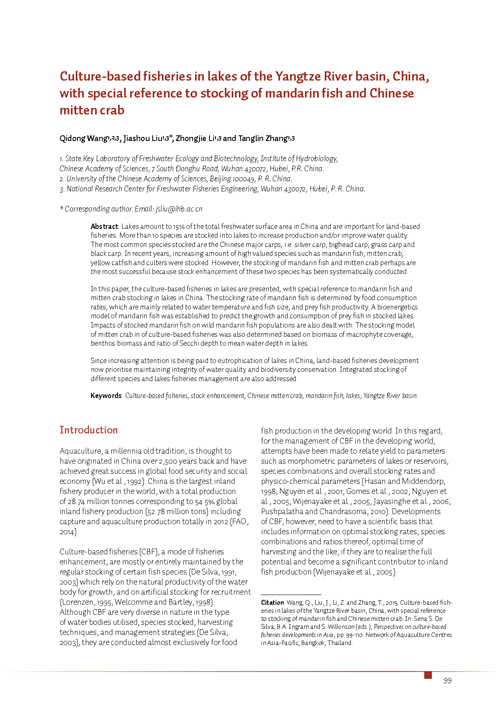Culture-based fisheries in lakes of the Yangtze River basin, China, with special reference to stocking of mandarin fish and Chinese mitten crab
12 May 2015 | Q. Wang, J. Liu, Z. Li and T. Zhang | 1452 Downloads | .pdf | 1.48 MB | China, Culture-based fisheries, Inland aquaculture
Lakes amount to 15% of the total freshwater surface area in China and are important for land-based fisheries. More than 10 species are stocked into lakes to increase production and/or improve water quality. The most common species stocked are the Chinese major carps, i.e. silver carp, bighead carp, grass carp and black carp. In recent years, increasing amount of high valued species such as mandarin fish, mitten crab, yellow catfish and culters were stocked. However, the stocking of mandarin fish and mitten crab perhaps are the most successful because stock enhancement of these two species has been systematically conducted.
In this paper, the culture-based fisheries in lakes are presented, with special reference to mandarin fish and mitten crab stocking in lakes in China. The stocking rate of mandarin fish is determined by food consumption rates, which are mainly related to water temperature and fish size, and prey fish productivity. A bioenergetics model of mandarin fish was established to predict the growth and consumption of prey fish in stocked lakes. Impacts of stocked mandarin fish on wild mandarin fish populations are also dealt with. The stocking model of mitten crab in of culture-based fisheries was also determined based on biomass of macrophyte coverage, benthos biomass and ratio of Secchi depth to mean water depth in lakes.
Since increasing attention is being paid to eutrophication of lakes in China, land-based fisheries development now prioritise maintaining integrity of water quality and biodiversity conservation. Integrated stocking of different species and lakes fisheries management are also addressed.
Creative Commons Attribution.

